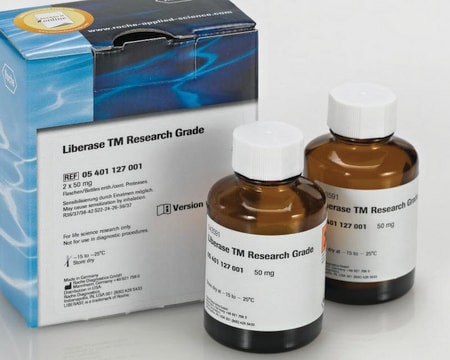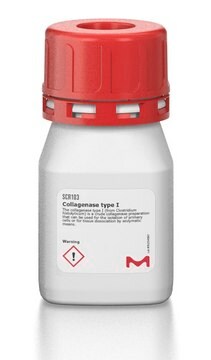Key Documents
COLLH-RO
Roche
Collagenase H
from Clostridium histolyticum
About This Item
Polecane produkty
pochodzenie biologiczne
Clostridium histolyticum
Poziom jakości
sterylność
non-sterile
Postać
lyophilized
collagenase activity
0.15 U/mg lyophilizate
opakowanie
pkg of 100 mg (11074032001)
pkg of 2.5 g (11087789001)
pkg of 500 mg (11074059001)
producent / nazwa handlowa
Roche
stężenie
~1 mg/mL (Isolation of rat hepatocytes)
~2 mg/mL (Isolation of adipocytes)
metody
tissue processing: suitable
kolor
brown
optymalne pH
6.0-8.0
rozpuszczalność
water: soluble
numer dostępu NCBI
numer dostępu UniProt
Zastosowanie
life science and biopharma
obecność zanieczyszczeń
Clostripain 39.798 U/mg
Proteases 14.014 U/mg (Azocoll, based on lyoph)
Trypsin 1.668 U/mg (with BAEE)
temp. przechowywania
2-8°C
Opis ogólny
Specyficzność
Zastosowanie
Postać fizyczna
Uwaga dotycząca przygotowania
Collagenase activity: >0.15U/mg (according to Wünsch) (+25°C, 4-phenyl-azobenzyl-oxycarbonyl-Pro-Leu-Gly-Pro-D-Arg as the substrate).
Contaminating enzyme activities: trypsin, clostripain, and total proteolytic activity
Collagenase H has a balanced ratio of enzyme activities, and is function tested for the isolation of rat hepatocytes (perfusion method).
Inhibitors:
Collagenase inhibitors: EDTA, EGTA, Cys, His, DTT, 2-mercaptoethanol
Collagenase is not inhibited by serum.
Clostripain inhibitors: TLCK
Trypsin inhibitors: aprotinin, trypsin inhibitor (egg white, soybean)
Activator: Ca2+
Working concentration: 0.5 to 2.5mg/ml,
Approximately 1 mg/ml for the isolation of rat hepatocytes and 2mg/ml for the isolation of adipocytes.
Storage conditions (working solution): -15 to -25°C
The reconstituted solution should be stored at -15 to -25°C for short term storage, -60°C or as described below for long-term storage.
Rekonstytucja
Przechowywanie i stabilność
Inne uwagi
Hasło ostrzegawcze
Danger
Zwroty wskazujące rodzaj zagrożenia
Zwroty wskazujące środki ostrożności
Klasyfikacja zagrożeń
Eye Irrit. 2 - Resp. Sens. 1 - Skin Irrit. 2 - STOT SE 3
Organy docelowe
Respiratory system
Kod klasy składowania
11 - Combustible Solids
Klasa zagrożenia wodnego (WGK)
WGK 1
Temperatura zapłonu (°F)
does not flash
Temperatura zapłonu (°C)
does not flash
Certyfikaty analizy (CoA)
Poszukaj Certyfikaty analizy (CoA), wpisując numer partii/serii produktów. Numery serii i partii można znaleźć na etykiecie produktu po słowach „seria” lub „partia”.
Masz już ten produkt?
Dokumenty związane z niedawno zakupionymi produktami zostały zamieszczone w Bibliotece dokumentów.
Klienci oglądali również te produkty
Produkty
Enzyme Explorer Key Resource: Collagenase Guide.Collagenases, enzymes that break down the native collagen that holds animal tissues together, are made by a variety of microorganisms and by many different animal cells.
Powiązane treści
Kolagenazy, enzymy rozkładające natywny kolagen, który utrzymuje tkanki zwierzęce razem, są wytwarzane przez różne mikroorganizmy i wiele różnych komórek zwierzęcych.
Nasz zespół naukowców ma doświadczenie we wszystkich obszarach badań, w tym w naukach przyrodniczych, materiałoznawstwie, syntezie chemicznej, chromatografii, analityce i wielu innych dziedzinach.
Skontaktuj się z zespołem ds. pomocy technicznej










